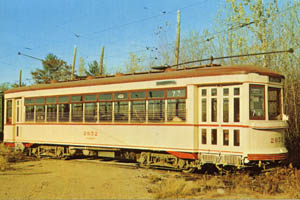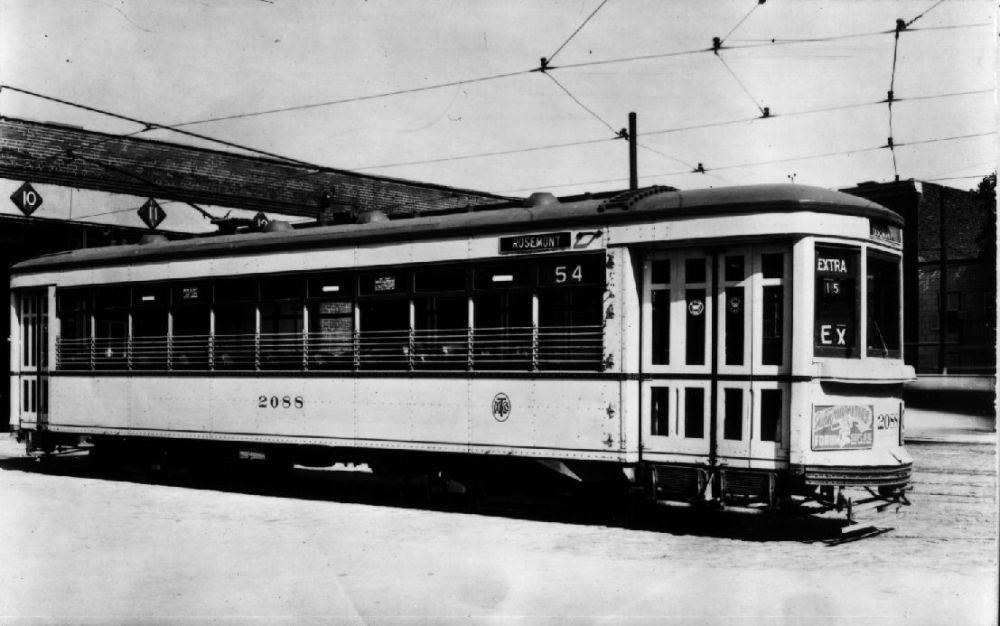
- Builder
- Wason Manufacturing Co.
- Description
- Lightweight
- Secondary Use
- None
- Type
- City and Suburban Streetcars
- Year
- 1927
- Retired from Service
- 1963
- Acquired by the Museum
- 1963
Montreal Tramways Co. 2052
From Montreal, Quebec
History
The Springfield Street Ry. Co. of Massachusetts purchased 50 lightweight cars, Nos. 555 – 604, from Wason in 1927. These were a style of double truck, lightweight, safety cars developed in the late 1920s. In lightweight cars, the sides of the car body carried all the loads, as opposed to a center longitudinal beam in older streetcar designs. The cars were termed “safety cars” because they could be run by one operator without needing a conductor. Springfield offered these cars for sale when streetcar service was about to end in 1940.
Montreal Tramways, under pressure since Canada was an early participant in World War II, bought 39 of these cars for its system, lengthening one platform and operating them as single-end, one-man, front-entrance cars. The front pole and rear controls were left in place for back-up moves. Montreal Tramways numbered the ex-Springfield cars Nos. 2050 – 2088 and placed them in service in 1941. No. 570 became Montreal Tramways No. 2052. Montreal Tramways painted its one-man and two-man cars differently so passengers could tell which end to board as cars approached the stop. No. 2052 received cream paint for one-man service. The ex-Springfield cars, with 35 hp motors, were not powerful enough to run on some Montreal routes with the steepest grades.
Montreal Tramways was taken over by the city-owned Montreal Transportation Commission in 1951. As the system began to contract in the post-war years, cut-backs of some lines increased the need for double-end cars. So, in 1952, the former Springfield cars had their remaining platform lengthened, restoring them to double-end operation.
Montreal streetcar service ended in 1959.
During the 1950s, Seashore members enjoyed visits to Montreal to experience an extensive, traditional streetcar system which had disappeared elsewhere in North America. When Montreal’s streetcar service ended in 1959, Seashore agreed to purchase several Montreal cars, but the museum first needed to add storage capacity and to build a loop to operate some of the Montreal cars which were single-ended. The Montreal Transportation Commission agreed to store the museum’s cars until Seashore was ready to receive them. No. 2052 came to Seashore in 1963 along with Montreal Nos. 957, 2652, 1176 and 1177. (Nos. 1176 and 1177 were used for parts and were not accessioned.) A year later, Seashore also enhanced its extensive Montreal collection with sightseeing car No. 2. Since double-end cars were needed for operations at Seashore and No. 2052 also represented Springfield, the museum chose this car for preservation. Museum members debated whether to restore the car to its Springfield or Montreal appearance. Seashore currently identifies it as a Montreal car. The car has seen substantial structural and cosmetic restoration. Seashore operated No. 2052 in regular service. However, Montreal had not adequately reinforced the underframe to support the longer platforms. So, the ends sag noticeably. In recent years No. 2052 has been held out of service due to additional needed structural work. A similar lightweight car acquired by Montreal Tramways from Springfield, No. 2056, is preserved at the Connecticut Trolley Museum in East Windsor, CT.
Technical Information
- Seats: 44
- Control: K-35
- Brakes: SME - M28
- Compressor: DH-16
Trucks
- Number: 2
- Manufacturer: Brill
- Model: 177E-2X
Motor
- Number: 4
- Manufacturer: Westinghouse
- Model: 510C
Weight and Dimensions
- Length: 44’ 6.00"
- Width: 8’ 4.00"
- Height: 11’
- Weight: 35650 lbs.
Additional Images

Russel Monrow in 1965

P.H.Bonnet in Montreal

Sister #561 in Longmeadow MA in 1939 from Don Shaw Collection
© 1998 - 2026 New England Electric Railway Historical Society. All Rights Reserved.